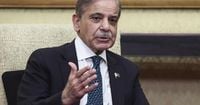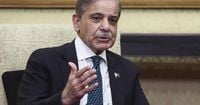Pakistan’s Prime Minister Shehbaz Sharif returned from his recent six-day visit to China with a headline-grabbing $8.5 billion in new investment agreements, signaling a fresh push for economic cooperation between the two countries. But behind the numbers and the official statements, a more nuanced story is unfolding—one that reveals both the promise and the persistent challenges of the China-Pakistan Economic Corridor (CPEC) and its much-touted second phase.
According to Associated Press reporting and Pakistan’s state media, the deals—finalized in Beijing on September 4, 2025—comprise $7 billion in memoranda of understanding (MoUs) and $1.5 billion in joint ventures. These agreements span a range of sectors, from agriculture and renewable energy to electric vehicles, health, and steel. The signing took place during Sharif’s attendance at the annual Shanghai Cooperation Organization (SCO) summit, a gathering that underscores the deepening ties between China and its regional partners.
But as reported by CNN-News18, not all is as straightforward as it seems. While the investment figures are impressive, much of the $8.5 billion is tied up in MoUs—essentially expressions of intent rather than hard cash. In fact, a top diplomatic source told CNN-News18 that Sharif’s delegation failed to secure new Chinese funding or mega projects for CPEC Phase 2. Instead, the Pakistani side left Beijing with MoUs and joint venture agreements, but without the direct, large-scale financial commitments they had hoped for.
At the heart of these developments lies the China-Pakistan Economic Corridor, a flagship component of President Xi Jinping’s Belt and Road Initiative. CPEC is designed to link western China’s Xinjiang region to Pakistan’s Gwadar port on the Arabian Sea, improving road and rail connectivity and boosting trade for both countries. The next phase, which Sharif unveiled during his visit, aims to accelerate these infrastructure projects and attract even more Chinese investment.
Yet the road ahead is far from smooth. During the Second Pakistan-China Business-to-Business Investment Conference, Chinese investors voiced concerns about the security situation in Pakistan—a worry that has long dogged the CPEC initiative. Attacks by Baloch separatists and Pakistani Taliban militants on CPEC-linked projects have been a persistent threat, prompting repeated calls from Beijing for stronger protections for its workers.
Sharif, for his part, did not shy away from these issues. In televised remarks, he assured Chinese investors that the safety of their citizens was paramount for Pakistan. "The safety of Chinese citizens is paramount for Pakistan," he stated, echoing a promise to enhance security measures for Chinese workers on Pakistani soil. This commitment was not just rhetorical; it was a direct response to the anxieties expressed by Chinese business leaders, who have seen their compatriots targeted in high-profile attacks in recent years.
But security is not the only hurdle. Chinese investors also raised concerns about bureaucratic delays and red tape that have hampered the smooth operation of previous investments. According to sources cited by CNN-News18, Sharif acknowledged these bureaucratic hiccups and pledged to remove obstacles to facilitate easier and faster investment flows. "My administration will remove all red tape hiccups in investments," Sharif reportedly told the conference, seeking to reassure his Chinese counterparts that Pakistan is serious about creating a more business-friendly environment.
Despite these reassurances, the Chinese government has so far remained publicly silent on the launch of CPEC Phase 2. Sharif announced the formal start of the next phase unilaterally, without a corresponding statement from Chinese officials. This lack of endorsement has raised eyebrows among observers, who note that China’s cautious approach may reflect lingering unease about both security and the overall investment climate in Pakistan.
Still, the agreements signed during Sharif’s visit are not insignificant. The $1.5 billion in joint ventures represents concrete partnerships between Chinese and Pakistani companies, with projects in sectors such as solar energy, chemicals, petrochemicals, iron, and steel. These ventures could bring much-needed jobs and technology transfer to Pakistan, especially as the country grapples with economic headwinds and a growing need for sustainable development.
According to data from IndexBox, global infrastructure investment under initiatives like CPEC has been a key driver of steel demand, with Pakistan’s imports of construction-related materials seeing a steady rise over the past year. This trend is expected to continue as new projects get underway, further integrating Pakistan into regional and global supply chains.
The expansion of CPEC is also a strategic priority for both countries. For China, the corridor offers a direct route to the Arabian Sea, bypassing the potentially volatile Strait of Malacca and securing vital energy and trade links. For Pakistan, CPEC promises improved connectivity, industrial growth, and a potential boost to exports—all critical ingredients for economic revival.
Yet, as the experience of the latest visit shows, realizing these ambitions requires more than just signed agreements and diplomatic handshakes. It demands concrete action on the ground: better security for foreign workers, streamlined regulatory processes, and genuine collaboration between public and private sectors. The Pakistani government’s repeated assurances are a start, but the real test will be whether these promises translate into tangible improvements for investors and local communities alike.
Political observers note that the optics of Sharif’s visit were carefully managed. While state media in Pakistan hailed the agreements as a major breakthrough, international outlets such as CNN-News18 highlighted the absence of new funding and the continued hesitancy on the Chinese side. This divergence in narratives reflects the complex interplay of domestic expectations and international realities that both governments must navigate.
Looking ahead, the next phase of CPEC will be closely watched by stakeholders in both countries. The success—or failure—of these investment agreements will shape not only the future of Pakistan’s economy but also the broader trajectory of China’s Belt and Road ambitions in South Asia. For now, the $8.5 billion in deals offers a glimmer of hope, but the journey toward genuine economic transformation is far from over.
As the dust settles on Sharif’s Beijing trip, one thing is clear: the China-Pakistan partnership remains a work in progress, marked by both high expectations and daunting challenges. Whether this latest round of agreements will deliver on its promise remains to be seen, but for now, the world is watching—and waiting.


